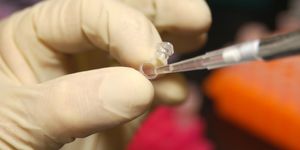New Drug 'Transformed' Infant Patients With Deadly Disorder
Spinal muscular atrophy (SMA) type 1 is a debilitating genetic disease impacting muscle development in infants. A new drug significantly improved symptoms in those patients; when treated, they were more likely to show improvement in motor function, and they were 47 percent more likely to live without needing a ventilator. The drug was so beneficial to patients in the study that it was halted early, and nusinersen was approved by the Food & Drug Administration for any individual with this disease. The results were reported in the New England Journal of Medicine and are outlined in the following video.
"This is transformative for children with SMA," commented the lead author of the study, Richard S. Finkel, M.D., the Chief of Neurology at Nemours Children's Hospital in Orlando. "Babies with this debilitating and deadly disease were destined to have a short lifespan and limited motor function. This study shows nusinersen is life-altering for families touched by this genetic disorder."
SMA impacts around one in 11,000 births, with about 60 percent of cases being the severe type 1; milder cases occur in children and adults. Around one in 40 adults carry the mutation that causes the disease. The severe neuromuscular disorder starts any time before six months of age and causes progressive weakness in muscles. Affected infants are never able to sit up and have trouble breathing and swallowing, causing lung infections. Most of these infants don’t survive to their second birthday unless they have a feeding tube or other help from devices.
Nusinersen is the first treatment option for SMA and acts on the SMN2 gene. A small piece of synthetic DNA, an antisense oligonucleotide (ASO) is injected into the spinal fluid directly, where spinal nerve cells absorb it. The ASO results in an increase in the synthesis of a protein that is needed for neuromotor development.
This study assessed 121 infants with SMA Type 1 who came from 31 centers in thirteen countries. Because both physicians and family members did not know whether a patient received the drug, it was a double-blind, randomized study. The researchers developed special procedures to ensure researchers interacting with patients did not know who had gotten medication through a spinal injection.
Over the course of thirteen months, 41 percent of the infants treated with nusinersen showed improvement in motor function, and several began to develop motor skills like sitting, standing, kicking, head control, and rolling over. No progress was seen in untreated infants in the control group. In nusinersen-treated infants, the risk of death was 63 percent lower, and they were less likely to need permanent ventilation assistance. There were not any serious patient problems after administration of the drug, which was well-tolerated.
The FDA approved nusinersen, sold as Spinraza, after checking the interim data from the study in December 2016. After the study ended, another one began to evaluate the long-term effects of the drug on these patients. It is also being tested in individuals with milder forms of the disease as well as infants found to have it through genetic testing, but who do not yet display symptoms. There is an effort by Dr. Finkel and colleagues to add SMA to a newborn screening panel so it can be diagnosed and treated immediately.
Sources: AAAS/Eurekalert! Via Nemours Children’s Health System, NEJM









